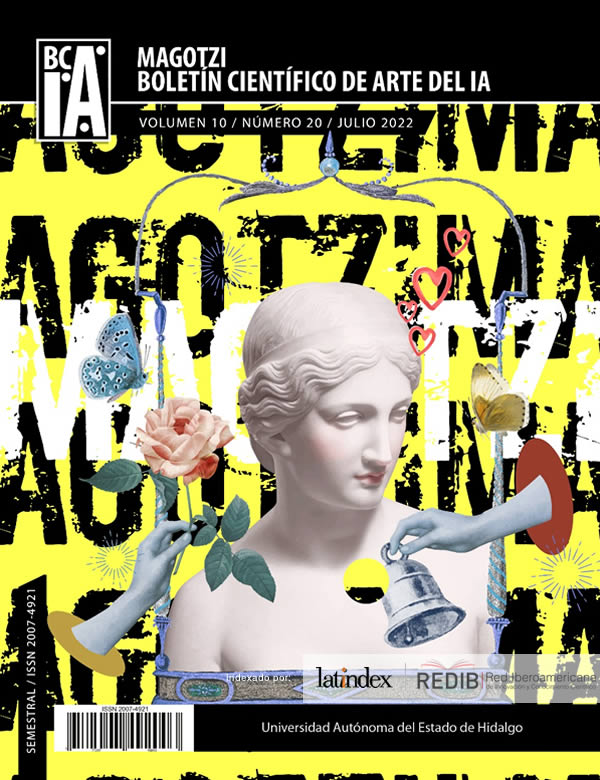Theatricality of the sacral body: a poetry against the grain in the art laboratory of Cecilia Lemus
Abstract
The following essay is a study of the dramatic writing of Cecilia Lemus that has always been politely cloistered in a devout sentiment, paradoxically the very postmodernity has allowed her to clarify and sustain a freedom of religious, mythical and ritual thought. Her poetics relies on the conformation of the body and the word of the knowing actor, germinated from a grammatical linguistics to function as a poietic device for the construction of feelings. This qualitative dissertation is reconstructed as a sacred didactics, with its own laws and norms of the religious Theater for the understanding of the characters of Albayalde (White lead) in the Skin of Salmon Art Laboratory. Her system of thought and her aesthetic ideas are thought in three great periods: The Theater of the Vaina Sacra (1995-1999). The theater of the Shines of the Finite (2000-2019) and the theater of the tenebrismo (2019-2021). The objective of this essay being the virtual assembly-process, of the Auto sacramental, as a methodology for the construction of characters.
Downloads
References
Lemus, Cecilia. “Bing Bang en el arte de la dramaturgia actual” Piel de Salmón progresa hasta hacer su Bing Bang. Ediciones Piel de Salmón. (s/f) Web. 28/06/2021
Cohen, C. Salomón. (2007). Martín Buber y su aproximación a la psicoterapia. Universidad Iberoamericana. México. Tesis Maestría. PDF
Fernández, Jean. Jorge. (2006). “Verbos de percepción sensorial una clasificación cognitiva”. Ed. Asociación de Jóvenes Lingüistas. Interlingüistica No. 16 Universidad de Alicante. Web. 28/07/2021
Rojas Garcidueña, José. (1989). Autos y Coloquios del Siglo XVI. Universidad Nacional Autónoma de México. Coordinación de humanidades. Biblioteca del estudiante universitario No. 4.
Iribarne, Leonardo. (2014). “El barroco y el neobarroco de Severo Sarduy”. Calamo Veintiuno.
La última tentación de Cristo. (2021). Libros de Mario.
Guía docente. (2021). Antropología Teatral. UCAM. Universidad Católica de Murcia. Grado en danza.
Kuri, Jorge. (1996). “La primera dramaturga medieval nacida en México”. Uno más uno [México] suplemento sábado. 31 de agosto de 1996. Página 11.
Centro Nacional de la Artes. “Hablemos de dirección con Luis de Tavira”. Youtube. 6 jul 2017. Web. 29/07/2021
Ynduráin, Domingo, 1943-2003. (2012). Los autos sacramentales. Publicación: Alicante: Biblioteca Virtual Miguel de Cervantes, III Jornadas de Teatro Clásico Español (Almagro, 1980), ed. J. Monleón, Madrid, Ministerio de Cultura, 1981, pp. 233-255. Web. 29/07/2021
Garin Martínez, Inma. (2018). Artes Vivas: definición, polémicas y ejemplos. Estudis Escénics. No. 43.
Arango, Manuel Antonio. (2021). “El teatro religioso en el barroco mexicano. Pensamiento y Cultura”. No. 121.
Parellada, Ricardo. (2000). “La naturaleza de las pasiones del alma en Descartes”. Revista de Filosofía, 3. ª Época, vol. XIII, núm. 23, págs. 235-242. Servicio de Publicaciones, Universidad Complutense. Madrid. PDF.
Basarab Nicolescu. (2021). “La transdisciplinariedad”. Manifiesto. Ediciones Du Rocher. Traducción al español revisada con el autor Norma Núñez-Dentin y Gérard Dentin. PDF.
Ortiz García, Carmen. Sánchez Gómez, Luis ángel. (1994). “Diccionario histórico de la antropología española”. Consejo superior de investigaciones científicas departamento de antropología de España y América. Madrid.
Castells C. I. (2016). “Vacas sagradas” La garriga. La Vanguardia.












